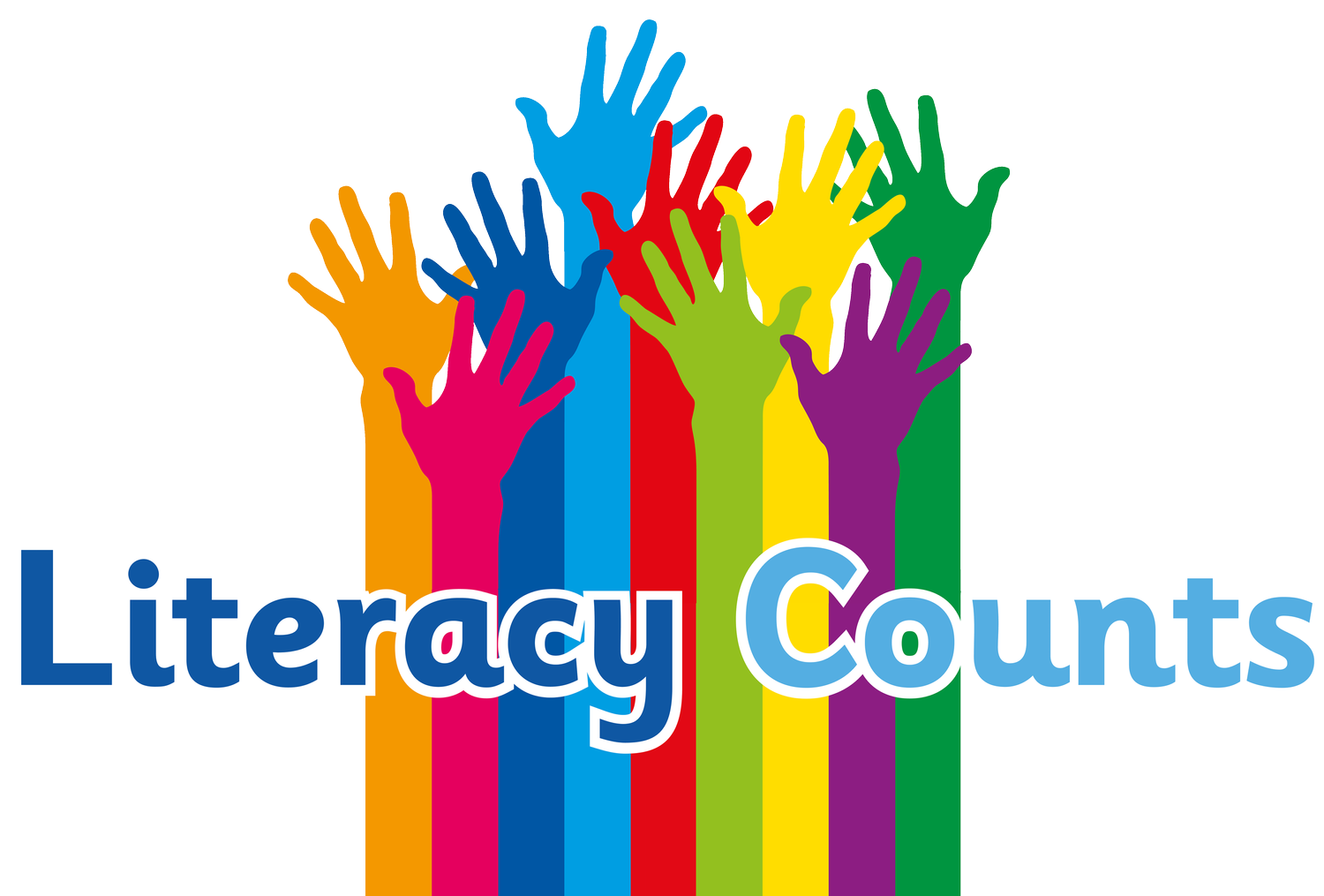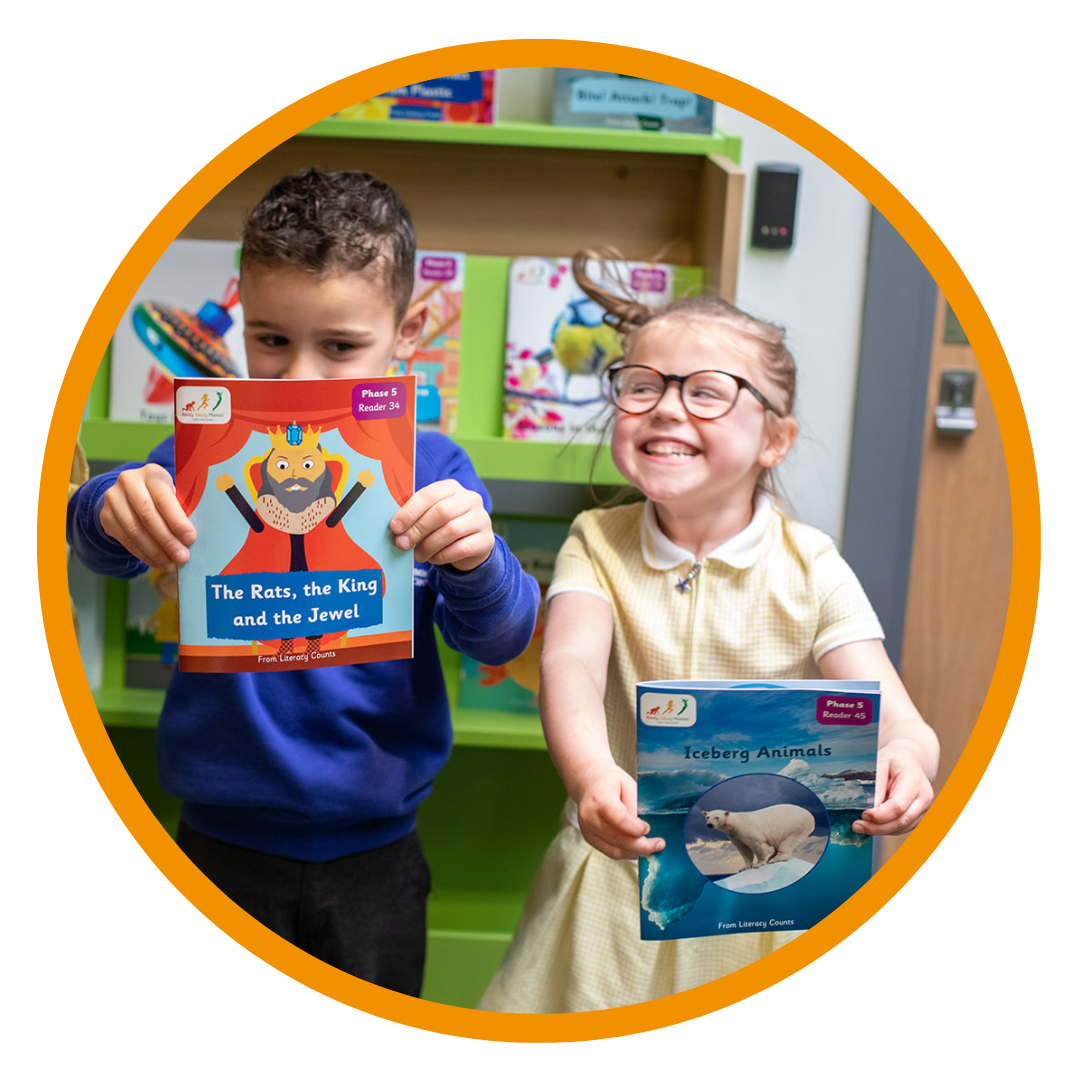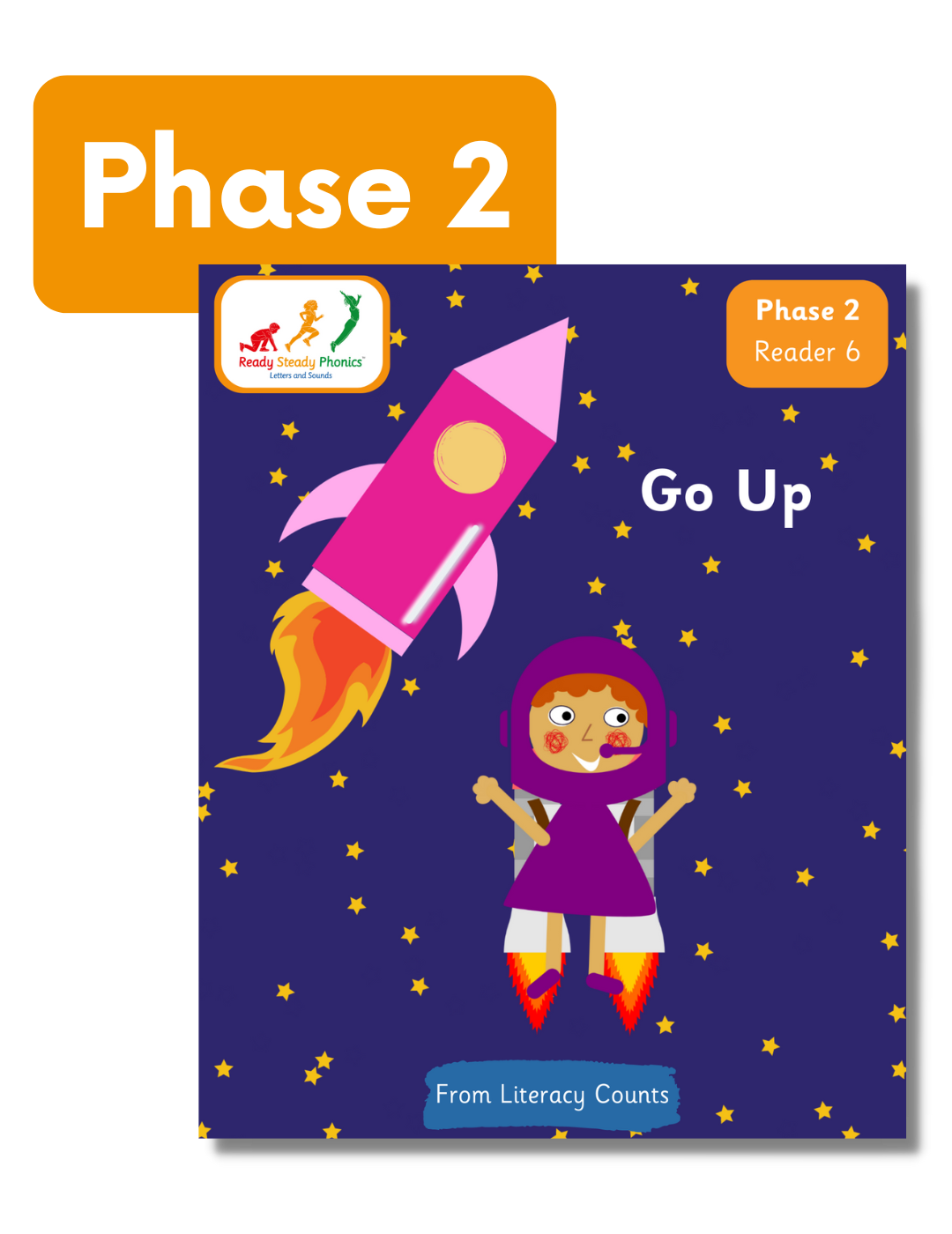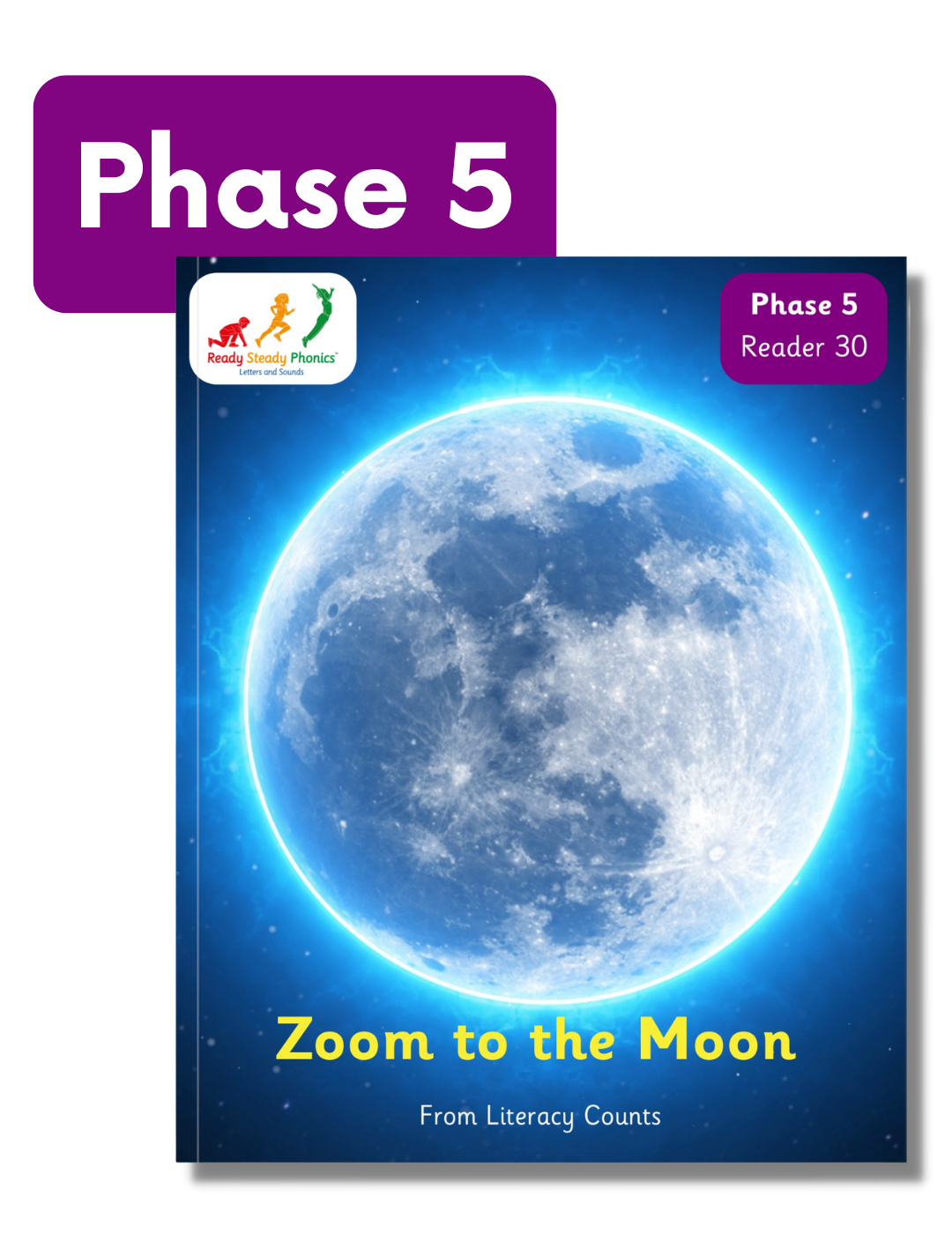Take a Closer Look at Ready Steady Phonics:
Explore our brochure to find out how Ready Steady Phonics delivers a validated phonics scheme for UK schools. Inside, you will discover how the programme offers fully resourced lessons, detailed guidance for teachers, and engaging decodable phonics books that are matched exactly to children’s phonic knowledge. You will also find information about QR-linked texts for home reading, daily lesson structure, and support for EAL and SEND learners.
Whether you are a MAT leader or school leader, this primary phonics programme provides everything you need to ensure consistent, high-quality phonics teaching across EYFS and KS1.
A Primary Phonics Programme with Fully Decodable Texts
This primary phonics programme provides a complete suite of resources to teach, practise and apply phonics knowledge. Children access high-quality, decodable phonics books that are perfectly matched to each phase of the programme, ensuring confidence and success at every stage of early reading development.
Teachers are supported with step-by-step planning, visual aids, QR-linked home reading materials and ongoing assessment. Ready Steady Phonics ensures that all children — including those with SEND or EAL — are given the tools to become fluent, independent readers from the very start.
Get in touch for sample access, training details & bespoke costings for your school!
Click here to connect with us.
A Validated Systematic Synthetic Phonics Programme
Ready Steady Phonics is a validated phonics scheme for UK primary schools, designed to give children a strong start in early reading. As a systematic synthetic phonics programme, it builds upon and expands the original Letters and Sounds with a carefully sequenced structure that matches pupils’ growing phonic knowledge and skills.
The programme includes fully decodable books, daily lessons, interactive activities and detailed teacher guidance — everything needed to ensure fidelity and consistency in phonics teaching across Reception and KS1.
Book Free Webinar ~
Book Free Webinar ~







Ready Steady Phonics is an online resource with everything teachers and leaders need to implement a sequenced and systematic phonics curriculum. All available at the click of a button!
Fully Resourced

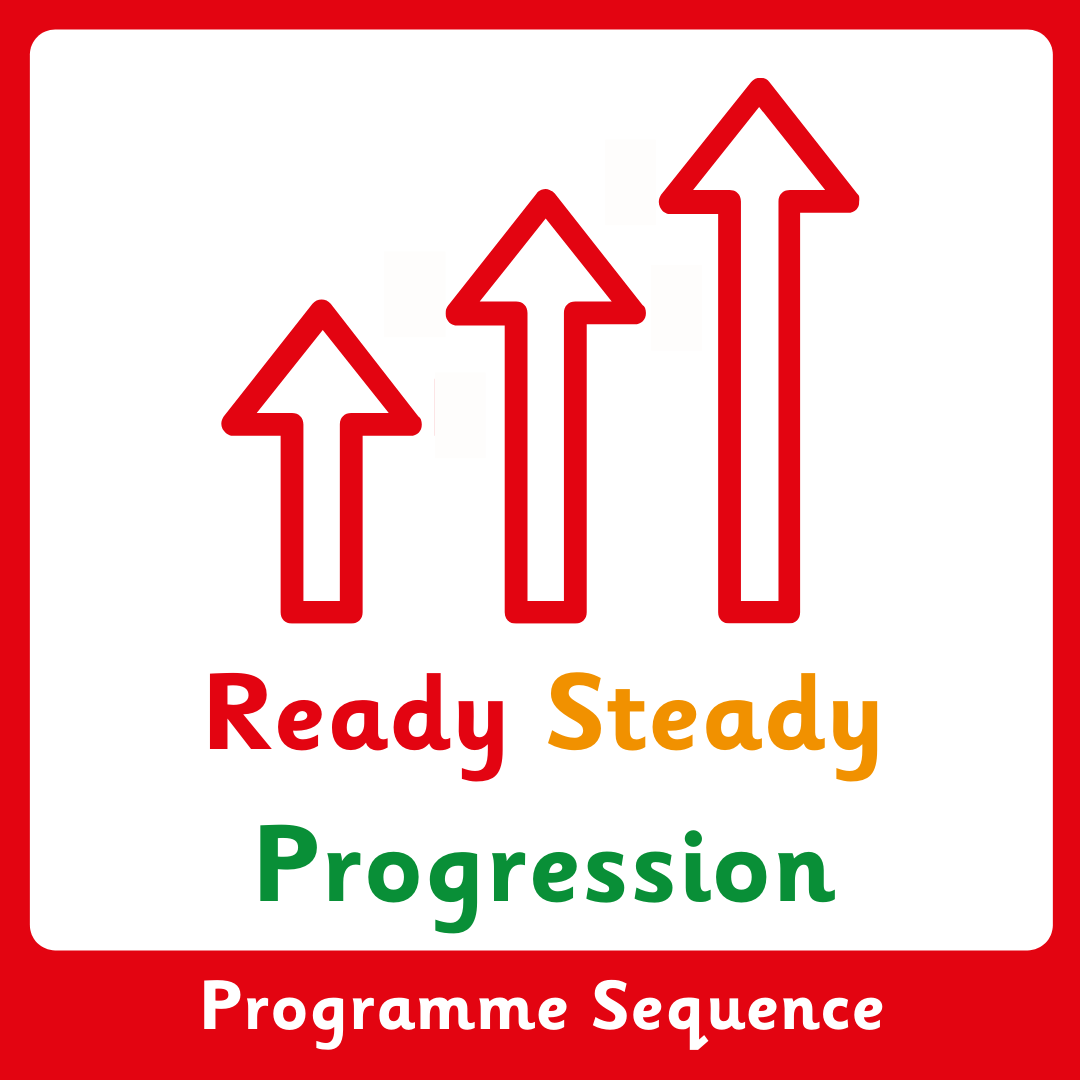
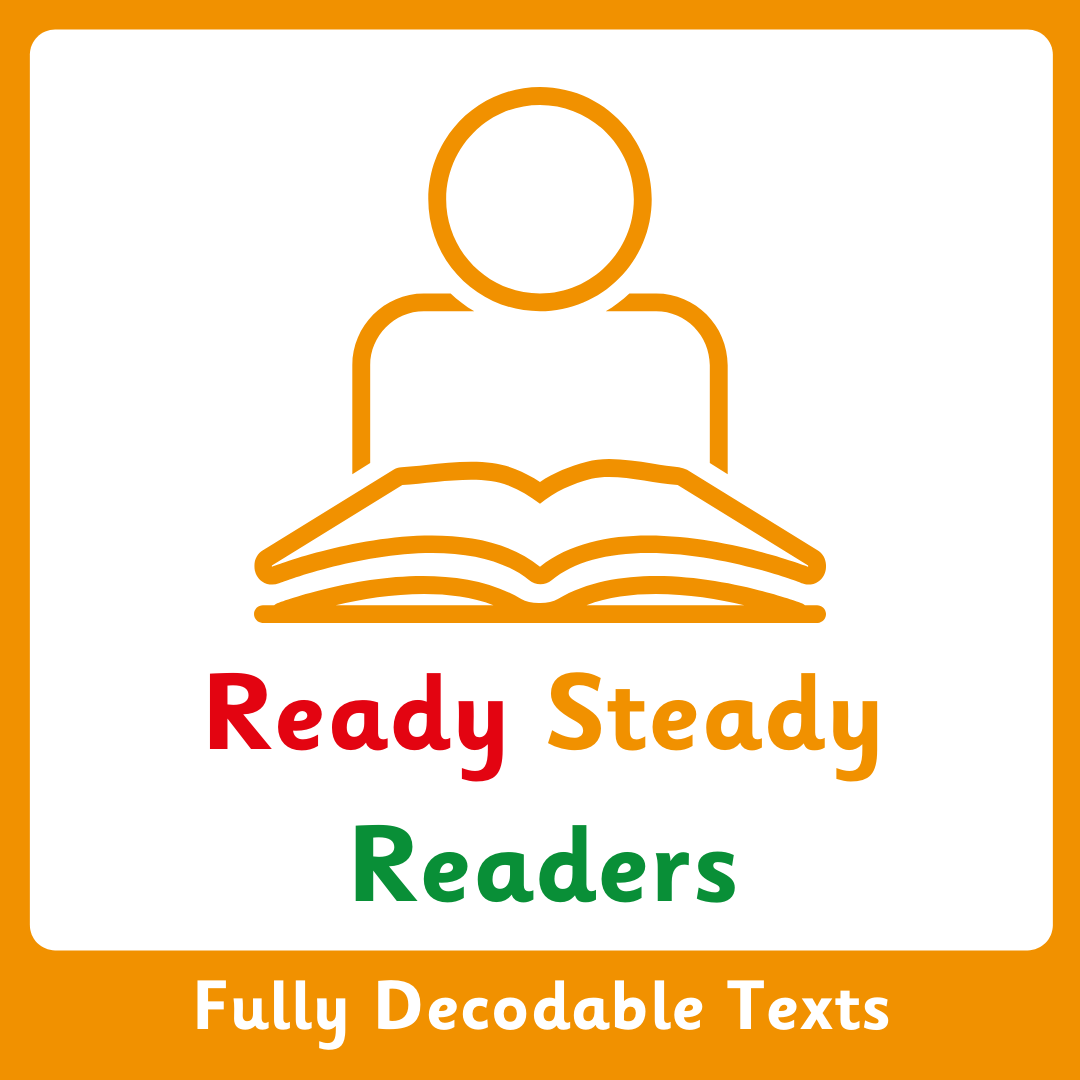
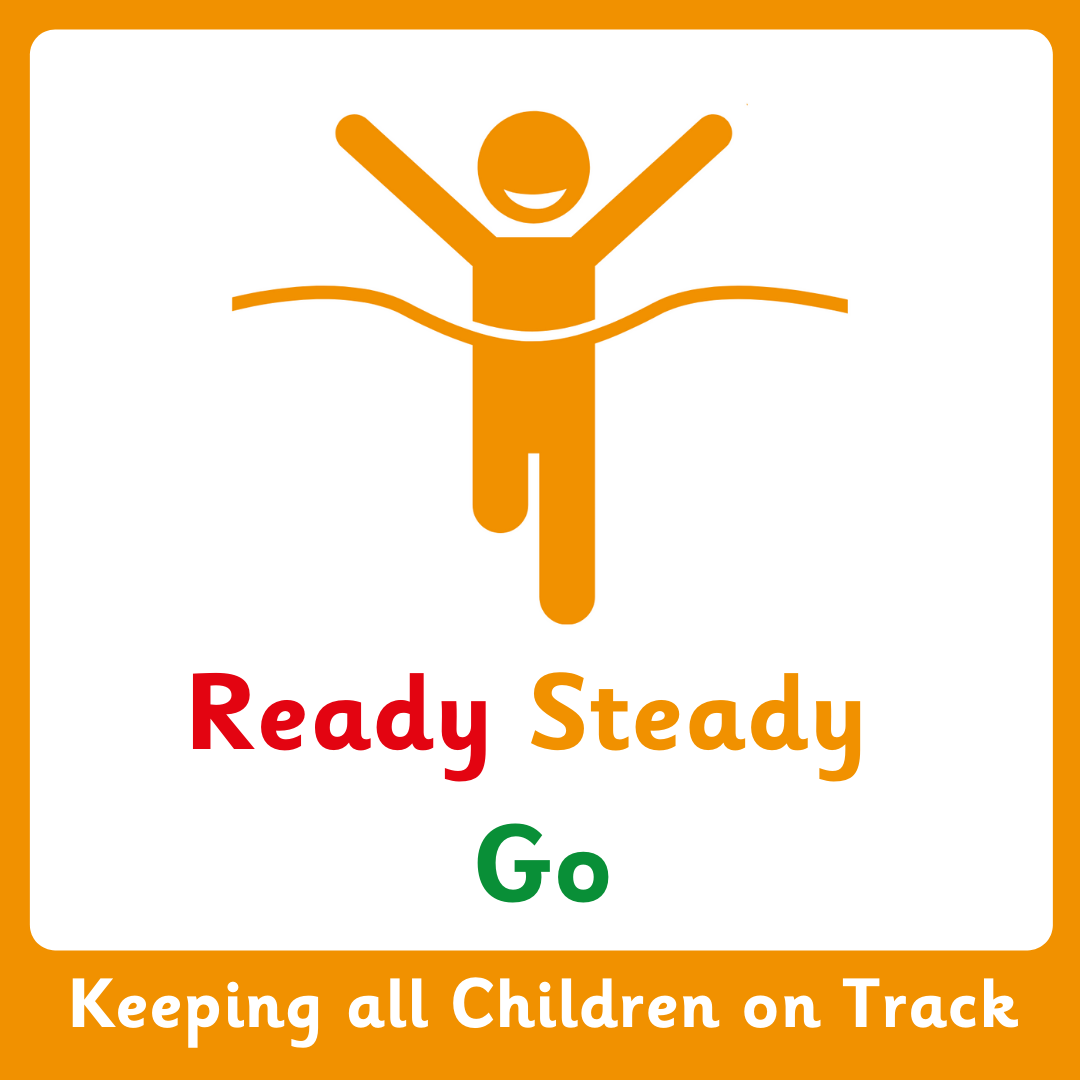
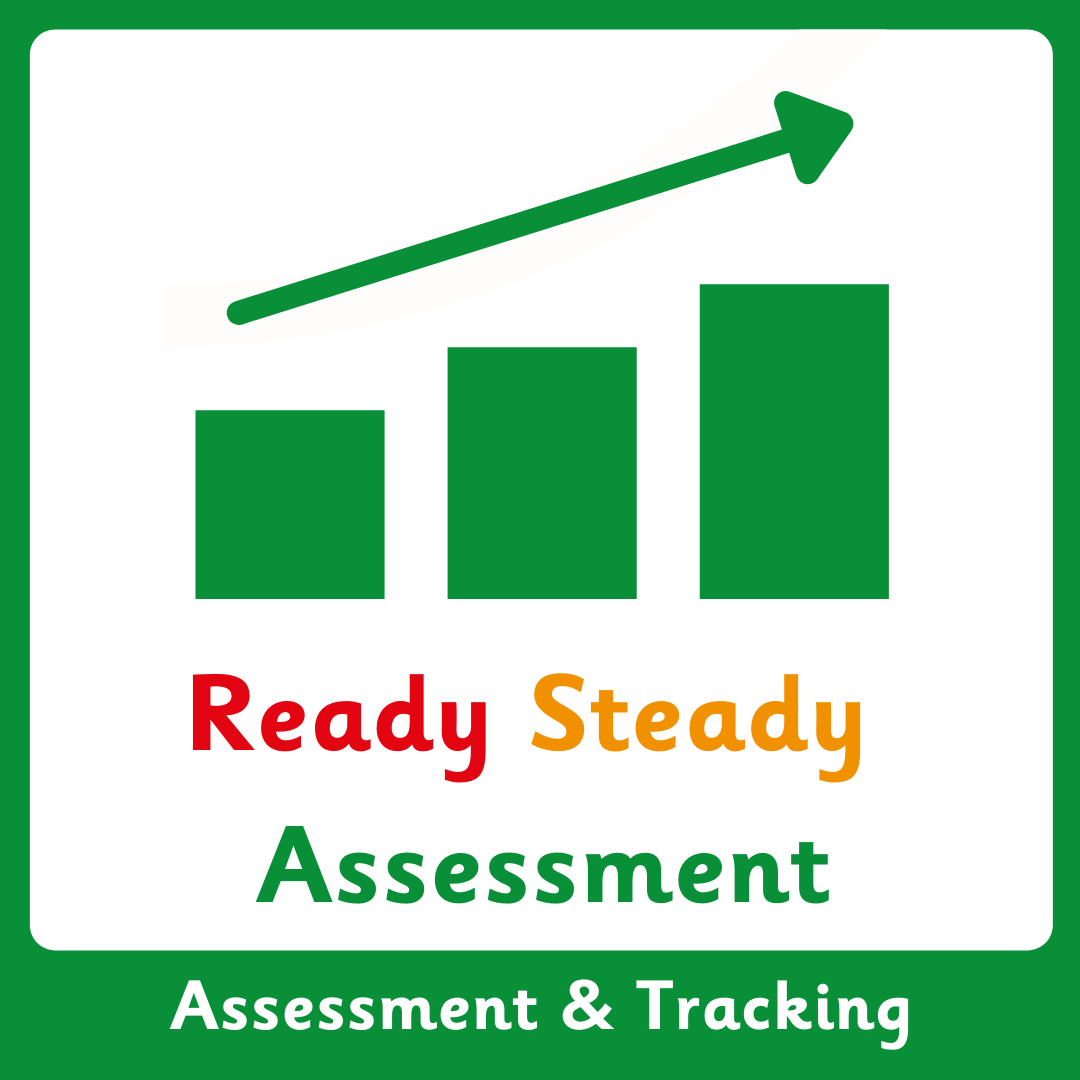
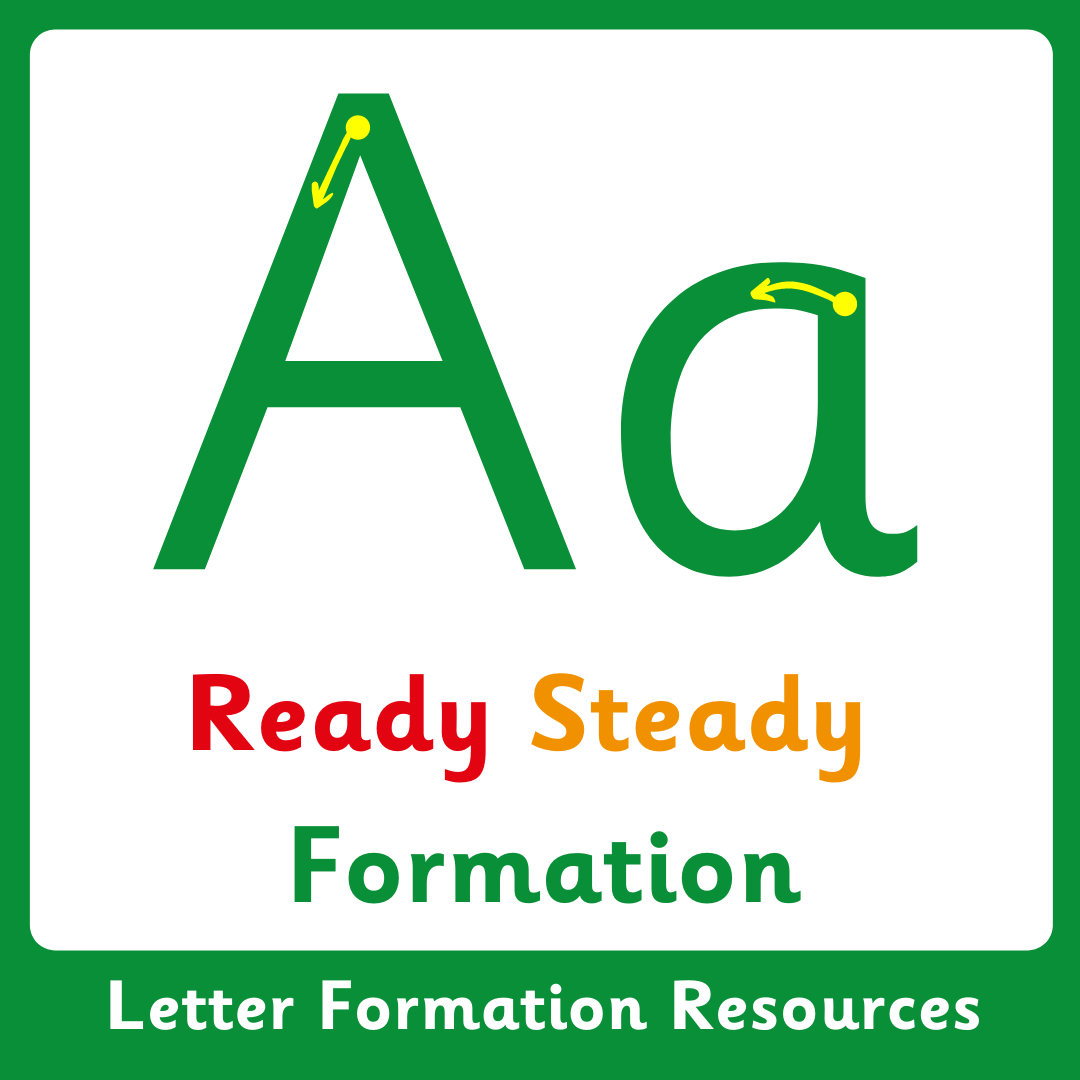

Physical Decodables

Daily Lesson Plans

IWB Resources

Assessment Resources

Digital Decodables

Letter Formation

Progression Documents

Weekly Workbooks

EYFS Story Friends

Intervention Support

Decodables on IWB

Online Training Modules
…and much more!
Have a look at some of our Decodable Texts!


What people are saying about
Ready Steady Phonics:
“Ready Steady Phonics works because it is sequenced in a way that makes learning stick.”
-Sam Rutter, Head of School, Barnton Community Primary School & Nursery
“Ready Steady Phonics enables teachers to deliver high quality phonics learning.”
- Nicky Dowling, Headteacher, Highfield Community Primary School
“The fully decodable texts are not only engaging they also match exactly to the teaching progression - such a carefully thought out programme that ensures high outcomes for all.”
- Alison Lawson, Director of Education, Weaver Trust
“Robust assessment systems ensure that no child is left behind and that gaps are closed for those children that need it.”
-Emma Boyd, Barnton Community Primary School & Nursery
Case Studies
-
School Context
Barnton is a larger than average size primary school with 484 pupils on role. The proportion of pupils known to be eligible for free school meals is above average. The very large majority of pupils are of White British heritage and the proportion of pupils from minority ethnic backgrounds is average, as is the proportion of pupils for whom English is an additional language. The proportion of pupils supported by school action plus or with an EHCP is above average. This is partly because the school has Primary Resource Provision for children with moderate and severe learning difficulties. Children typically enter Reception well below average and usually leave Barnton reaching, or exceeding, age related expectations.
1. How has the Ready Steady Phonics professional development supported practitioners’ phonic subject skills and Knowledge?
There has been a strong impact through the quality CPD as part of the Ready Steady training. All staff from leadership through to our TAs feel confident and competent in delivering a high quality phonics diet for our children. All staff have a sound understanding of how we teach phonics and why we do it using the progression documentation that is part of the programme. Staff are adept at ensuring children overlearn and use effective pedagogies to ensure learning ‘sticks’ and children apply their learning in a variety of contexts.
2. How has Ready Steady Phonics professional development improved the Quality First Teaching of phonics at your school? (e.g., modelled sessions, online CPD face to face CPD)
Phonics lessons are now refined and ensure they are consistent across year group classes and phases. Staff use common ‘patter’ and children are able to feel familiar and confident in Phonics lessons due to the consistency and precision teaching being delivered.
3. What has been the impact on children attainment and progress?
Children in reception are on track to complete the ambitious progression laid out in the Ready Steady Phonics Progression document. Children are writing more, spelling more accurately and are more motivated to read. Children are seeing the relationship between the phonics lessons and how they can apply this knowledge to their reading and writing. Common Exception Words are consistently remembered and read more accurately across Reception & Year 1 than in previous years. In Year 1, this is also being demonstrated by application in their writing.
Ready Steady Phonics is impacting positively across KS1 and EYFS. From ongoing assessments, it is noted that children are remembering more and applying phonics more consistently. Something that is remarkable given the impact of the global pandemic on children’s outcomes. In Year 1, we assessed that 33% of children were on track in Autumn 1 2021. In Spring 2 2022, we have assessed that 85% of children are now on track. This is due to not only the consistency of QFT but also the impact on the ‘Ready Steady Go: Keeping all children on track’ sessions. Formative assessment in phonics has now come to the forefront of staff’s minds due to construction of the workbooks. This is leading to fluid and supportive groups where staff are pinpointing children’s misconceptions and addressing at the point of learning or soon after in Ready Steady Go additional sessions.
In Reception particularly, parents are accessing the decodable books at home and have said they are engaging their children in reading more due to the interesting nature of the books and their familiarity to the children.
4. In your role as a leader, how has Ready Steady Phonics helped you ensure fidelity to the programme and high quality of teaching and learning?
Ready Steady Phonics is very explicit and highly structured. It is organised in such a way that ensures teachers are making learning cumulative to ensure that it sticks. This structure also helps maintain the momentum and pace of lessons across the week, across the term and across the year. As a leadership team, this has given us the confidence in knowing that Phonics is being taught to a high level in every classroom and children are consistently making good progress. The rigor of the Ready Steady Go part of the programme ensures that, as a leadership team, we know children are being supported to keep up in their Phonics learning.
5. How has the Ready Steady Go (Keeping children on track) enabled those children that fall in the bottom 20% to close gaps in attainment?
The Ready Steady Go element of the programme has ensured that all staff, including TAs, are able to use formative assessment to quickly identify those children at risk of falling being and put additional support in place to ensure misconceptions are addressed. This part of the programme has been instrumental in narrowing the attainment gap. The children working below the expected standard in phonics has dramatically decreased and more children are now meeting age related expectations in reading and writing.
6. How do programme resources support children in their acquisition of phonics subject skills and knowledge?
IWB materials are very clear and help shape the lessons with strong visuals that engage the children whilst keeping the focus on the learning. The flashcards and repeated phrase e.g., /sh/ as in shark, provide a scaffold between the grapheme and phoneme making it memorable. Children can often be heard using this patter in their independent learning. The handwriting patter has been particularly helpful in Reception with it being so simple and easy to remember whilst being focussed on the actual shape of the letter. The clarity of the teaching resources removes cognitive load and stimuli that would otherwise result in distractions and increased misconceptions.
7. How are children engaging with the fully decodable texts?
All stakeholders love the decodable readers that are part of Ready Steady Phonics programme. Ensuring the children have multiple encounters with the text, gradually increasing their independence, ensures their confidence in reading. With a range of information, rhyming and story books children are interested and motivated to read.
8. Literacy Counts (who developed Ready Steady Phonics) has been supporting your school for a number of years please indicate the percentage of children that pass the phonics screening check.
Year 1: 2021 (81%)
Year 1: 2022 (87%)
Year 1: 2023 (90%)
Year 1: 2024 (92%)9. Would you recommend the programme to other schools why / why not?
We absolutely would recommend Ready Steady Phonics to other schools. The scheme is clearly entrenched in pedagogical research and ensures outcomes for all children at all levels. The resources are of a high quality and the decodable readers link perfectly with the programme whilst still being engaging and promoting a love of reading and the teaching of comprehension.
10. How have the formative assessment footnotes and final page questions informed the identification of children’s needs for daily Ready Steady Go sessions?
The formative assessment footnotes have really raised the profile of formative assessments amongst teachers and TAs alike. The early identification of misconceptions and children who could potentially fall behind ensure that the Ready Steady Go sessions are purposeful and focussed on supporting the children who need it most.
11. How have the Assessment Interval summative assessments identified gaps in children’s phonic knowledge and skills?
Summative assessment ensures staff can gather information about the learning children have remembered and it informs future planning.
12. How have the letter formation animations, letter patter and practice sheets impacted on children’s letter formation?
The letter patter is clear and stripped back, ensuring that children focus on the letter shape rather than other distractions. This also gives the children the opportunity to overlearn which in turn develops children’s confidence in their ability to form the letters they have learned. Daily handwriting and Ready Steady Go sessions has ensured children are given opportunities to further practise their handwriting. There has been a clear improvement in children’s letter formation and fluidity in writing.
13. How has the Ready Steady Phonics Teaching Progression connected/aligned with the cross curricular teaching and progress in Reading, Writing and Spelling?
There are several decodable books that link directly to areas of the national curriculum for Science, History and Geography (Y1) and Knowledge and Understanding of the World (EYFS). Resources like phoneme frames, flashcards, CEW phoneme mats are used across the curriculum to ensure a broader application of phonics subject skills and knowledge (outside Ready Steady Phonics lessons). The progression of Ready Steady Phonics aligns closely with outcomes in the ELGs and Year 1.
-
School Context
This is an average sized primary school with 233 children. Almost all pupils are of White British heritage. The proportion of pupils known to be eligible for free school meals is slightly above the National level. Pupils with Special Educational Needs including those with EHC plans is slightly above the National level.
1. How has the Ready Steady Phonics professional development supported practitioners’ phonic subject skills and Knowledge?
Ready Steady Phonics CPD has provided a positive impact. It has stimulated meaningful professional conversations about phonics acquisition and progression between Teachers TAs and Leadership across the key stages. TAs who also received CPD have a clear understanding of their role within the Ready Steady Phonics Programme.
2. How has Ready Steady Phonics professional development improved the Quality First Teaching of phonics at your school? (e.g., modelled sessions, online CPD face to face CPD)
Quality First Teaching has been enhanced by a more streamlined focus and delivery of phonics, followed by an improved system for practise and application through the use of workbooks. Through monitoring and supporting the teaching and learning within the school and through modelled sessions at the CPD session, practitioners understand the rationale behind the phonics teaching and learning of Ready Steady Phonics. The ‘what’ the ‘how’ and the ‘why’ of the effective teaching of phonics. All practitioners appreciate that they have an integral part to play in the delivery and monitoring of the programme.
3. What has been the impact on children attainment and progress?
Most children in Reception are on track to complete the ambitious progression laid out in the Ready Steady Phonics document. There is evidence of children having greater confidence in independent writing and spelling. Children are showing greater confidence with their reading sooner than previously experienced, since the introduction of Ready Steady Phonics. Common Exception Words in particular, are consistently read more accurately across Reception & Year 1. Children clearly understand the relationship between what they learn in the phonics lessons and how this can be applied in their reading and writing.
Even with the lost learning that covid-19 invited, children in YR are well on their way to achieving the expectations outlined in the Ready Steady Phonics Teaching Progression document. Beyond this, in Reception, parents are conveying to us that many children display more positive attitudes and dispositions to reading and are more actively involved in reading at home.
Overall, Ready Steady Phonics is impacting positively across KS1 and EYFS.
4. In your role as a leader, how has Ready Steady Phonics helped you ensure fidelity to the programme and high quality of teaching and learning?
Ready Steady Phonics follows a tightly structured format which ensures focus and pace is maintained effectively throughout the programme. This provides the leadership team with a clear understanding of what is being taught and when. It is structured in such a way that planning and progression documents that accompany power point presentations ensure practitioners keep to the agreed teaching method/approach. Children’s workbooks show evidence of progress. This structure also helps maintain the momentum and pace of lessons across the week, across the term and across the year. Leadership, Teachers, TAs and pupils are very clear about the expected outcomes of the teaching and learning.
5. How has the Ready Steady Go (Keeping children on track) enabled those children that fall in the bottom 20% to close gaps in attainment?
Ready Steady Go sessions address very quickly identified gaps for those children that need additional sessions. Working in smaller groups and 1:1 has also benefited those children that make progress less quickly.
In Year 1 some of our children who fall in the bottom 20% of the phonics sessions have responded very positively to the structure of the programme. The explicit delivery of the programme coupled with clear expectations and outcomes has enabled them to take a more active role in their learning. They are able to chunk their learning into achievable parts and this gives them a greater sense of control in relation to the work they do. In addition, there is a heightened awareness of how they see themselves as learners and how they learn. They are on their way to developing metacognitive skills.
Having a focus group offers many opportunities to closely monitor and respond in a timely fashion to the needs of the children.
6. How do programme resources support children in their acquisition of phonics subject skills and knowledge?
IWB materials are very clear and help shape the lessons with strong visuals that engage the children whilst keeping the focus on the learning. The flashcards and repeated phrases e.g., /sh/ as in shark, provide a scaffold between the grapheme and phoneme making it memorable and aids recall. Resources such as phoneme frames, phoneme flashcards, phoneme phase mats and CEW phoneme mats are available in the classroom for children to refer to in their reading and writing. The workbooks provide practise in letter formation, blending to read, segmenting to spell, spelling procedures, CEW, dictation skills.
7. How are children engaging with the fully decodable texts?
Parents, practitioners and children alike have provided positive feedback with regard to the decodable readers that are part of Ready Steady Phonics programme. There are multiple opportunities through shared reading, guided reading, paired reading and individual reading to support the application and consolidation of GPCs. In short, multiple encounters of a text prior to independent reading have given children greater confidence and a sense of achievement. They are now recognising that they can read for pleasure as well as for practise. With a range of information, rhyming and story books children are interested and motivated to read.
8. Literacy Counts (who developed Ready Steady Phonics) has been supporting your school for a number of years please indicate the percentage of children that pass the phonics screening check for the last three years. 2018, 2019, 2021
Year 1: 2019 (75%)
Year 1: 2020 (Covid) 93% in December 2020
Year 1: 2021 (89%)
9. Would you recommend the programme to other schools why / why not?
YES! Ready Steady Phonics is clearly thought out and straightforward to use once one has mastered the instructions. Daily planning and progression documents are easy to follow. Children are engaged. There are plenty of opportunities to consolidate learning. The workbooks are an effective way to practise and apply learning and children enjoy using them. The decodable books accessed online have proved very successful.
Ready Steady Go provides a wealth of ideas to support children who require support at Wave 2 and 3.
10. How have the formative assessment footnotes and final page questions informed the identification of children’s needs for daily Ready Steady Go sessions?
These draw the teacher’s attention to misconceptions and common barriers to learning, immediately. This allows for reflection and remediation sooner rather than later. Children don’t get the opportunity to repeat misconceptions. We understand that practice makes permanent. ‘The more we practice something the more automatic it becomes. If we practice doing something badly we get better at doing it badly.’ David Didau
11. How have the Assessment Interval summative assessments identified gaps in children’s phonic knowledge and skills?
They provide focus in a number of different areas integral to learning. Instructions on using the assessments are clear and concise. The material is easily accessible to children. The writing and spelling sections are particularly useful as they provide immediate ‘feedback’ regarding misconceptions/difficulties with spelling. The assessments provide significant analysis for subsequent use in Ready Steady Go sessions.
Assessments provide information about children’s progress against the following areas:
· reading CEW
· blend to read real words & pseudo words
· segment to write words
· spell CEW
These collectively help build a profile of a class and individuals therein. This data is helpful for leaders to offer support and deployment of resources. These summative assessment intervals are punctuated through the year and help Teachers monitor the pace outlined in the teaching progression document. This is another way to clarify what the formative ongoing assessment and Ready Steady Go sessions has been showing through the term. They ensure that gaps are addressed.
12. How have the letter formation animations, letter patter and practice sheets impacted on children’s letter formation?
Children have learned the patter and use this when forming letters during their Ready Steady Phonics lessons. The programme makes letter formation very clear through the animated letter movement slides and through modelling and prompting in daily practise in their workbooks. Additional sessions that focus on letter formation during Ready Steady Go Sessions provide opportunities for reinforcement and overlearning.
13. How has the Ready Steady Phonics Teaching Progression connected/aligned with the cross curricular teaching and progress in Reading, Writing and Spelling?
There are several decodable books that link directly to areas of the national curriculum for Science, History and Geography (Y1) and Knowledge and Understanding of the World (EYFS). Resources such as phoneme frames, phoneme flashcards, phoneme phase mats and CEW phoneme mats are used across the curriculum to ensure a broader application of phonics subject skills and knowledge (outside of Ready Steady Phonics lessons).

FAQs
-
Ready Steady Phonics Letters and Sounds is a progressive systematic synthetic programme which builds upon and expands the original 2007 Letters and Sounds. It contains detailed guidance for effective implementation, and carefully crafted fully decodable texts that exactly match children’s growing phonic subject skills and knowledge. It also aligns to current National Curriculum requirements and the Revised EYFS Curriculum 2021. It has a well-defined, cumulative progression for the teaching of Grapheme-Phoneme Correspondences (GPCs) and Common Exception Words (CEW) for reading and spelling in Reception and KS1.
-
Adapting Ready Steady Phonics is easy. The IWB lessons can be shared by the practitioner during the online lesson using a variety of platforms such as Zoom, Google Classroom, Teams etc. The lesson would be followed in accordance with the guidance found in this Ready Steady Teach document. Workbooks can be downloaded and provided for children. Whilst the IWB lessons do not replace face-to-face teaching and are used as an aide memoir for in-class teaching, they provide an effective online delivery.
The practitioner has a choice of either live teaching using the IWB materials or pre-recording lessons to share with parents & carers. Schools will need to make downloadable Workbooks available to children. During live teaching the Workbook element (Practise & Apply) of the lesson could be taught and shared using your online platform.
Practitioners may also choose to live stream whole class Shared Reading of decodable texts, prior to the children’s independent access.
-
Some children simply require meeting the content more times to secure understanding of new concepts, skills and knowledge. Close monitoring and prompt subsequent intervention for children that fall into the schools’ lowest 20% is an essential component of this programme. Therefore, there is a need for immediate extra phonics support to address common difficulties. This is referred to as Wave 2. These regular additional sessions are for small groups and individuals with similar identified needs that demonstrate common barriers in phonic development. These additional sessions must be referred to as a Ready Steady Go to avoid negative connotations. They are vital in ensuring all children’s potential is realised.
-
Some children that fall within the bottom 20% of attainment may also have significant difficulties and barriers that impede progress. These identified children will need tailored intervention on a 1:1 basis which addresses individual difficulties. Ready Steady Go adapted materials can also be used as part of a schools Wave 3 approach for individual children with SEND.
-
Wave 2&3 Ready Steady Go sessions use the same resources and practices already used in the QFT Ready Steady Phonics session. This is intentional so that activities are familiar to children and practitioners. This keeps the focus on the intended learning outcome. Learning ‘rules’ for new activities or time-consuming preparation of resources is not good use of limited time. In short, there is no requirement to generate separate Ready Steady Go lesson plans.
Additional adaptations to the programme must be made for SEND children and those with specific difficulties. Close observation during Ready Steady Phonics (Wave 1) Ready Steady Go (Wave 2) sessions will allow for a more specific, tailored approach to support those individuals not making the required progress. Children will profit from detailed diagnostic assessments and close observations to gain a thorough understanding of their phonic difficulties and behaviours at word level reading.
All information for members is available in Ready Steady Go: Keeping all Children on Track.
-
The teaching of letter formation including capital letters, is integral to the Ready Steady Phonics Letters and Sounds programme. From the outset in Reception, children learn the grapheme that represents the phoneme and alongside this, they are taught how to form the letter(s) correctly. Children also learn an accompanying letter formation patter for each letter of the alphabet. In this way children are jointly developing their aural, visual and motor memories for graphemes and phonemes within the lesson.
-
Decodable books are books that are written for the beginning reader and contain the specific phonics matched to the teaching taking place. This provides learners with the opportunity to use their developing phonics skills to be able to read quickly and effortlessly.
These books are written for the specific purpose of being able to practise the phonics children have just been taught and become fluent at decoding the words in that book. This is the focus of all decodable books which are part of a SSP phonics scheme.
The Dfe clearly states that “the texts and books children are asked to read independently should be fully decodable for them at every stage of the programme. Practising with such decodable texts will help to make sure children experience success and learn to rely on phonics strategies”.
The current 2021 OFSTED criteria also required schools to give pupils sufficient practice in reading and re-reading books that match their current phonic levels and states that this needs to happen at home and at school. This is one of the criteria around early reading and phonics the school will need to evidence in any OFSTED.
The Ready Steady Phonics scheme has been written in line with the current Dfe expectations. The books have been written to align with the progression in the teaching of phonics, to allow children to be able to practise what they have just been taught. Ready Steady Phonics also allows and plans for re-reading of the phonically matched texts a number of times. Frequent re-reads of these texts across the week are designed to develop their reading stamina, confidence and fluency in their journey to becoming a reader.
-
All children using the phonics reading scheme will need to have a decodable, matched book. The current expectations are that a child would be using the phonically decodable books linked to the phonics scheme until the end of Year 1 and into Y2 unless further support in decoding was required.
However, alongside that children should be encouraged to enjoy reading for pleasure and enjoyment. We want all children to enjoy reading and to be able to view themselves as lifelong readers. You can encourage your child in this by listening to your child read their decodable book to you, practicing and consolidating their phonics skills, but share other texts they have brought home from school, read to them, share stories you love, discuss what they have read, share library books etc.
This will allow the development of their understanding of stories, develop pleasure and enjoyment and follow some of their own interests in reading.
Join our mailing list!
Join our mailing list to keep up to date with news and upcoming courses!
